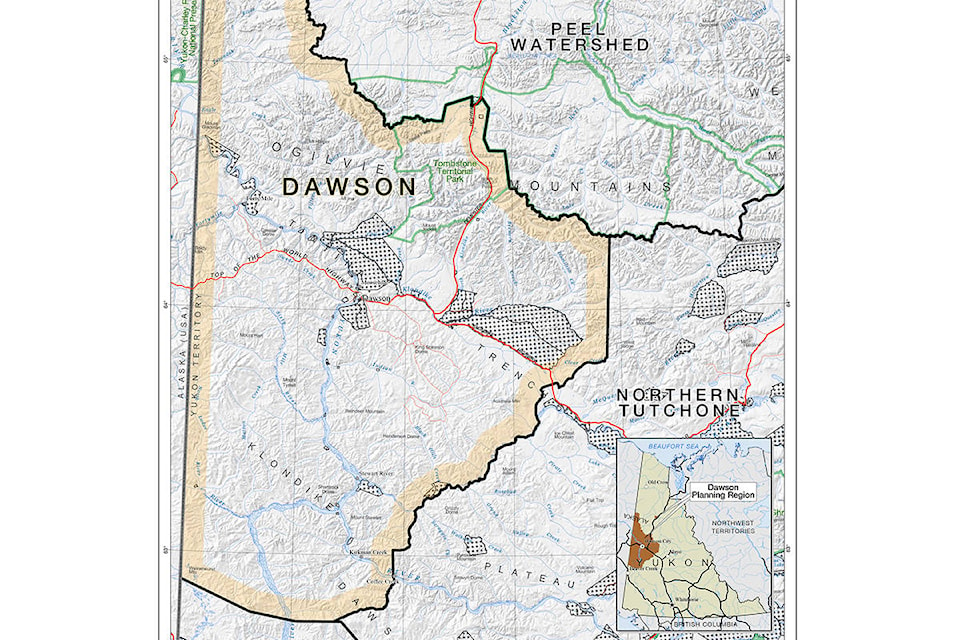The Yukon government has withdrawn a portion of west-central Yukon from mineral staking during land-use planning.
“This will minimize future land-use conflicts in areas that are likely candidates for conservation,” said Environment Minister Pauline Frost in a statement.
Approximately 12 per cent of the Dawson planning region has been withdrawn from staking, the government announced on March 11.
The Dawson region encompasses about 40,000 square kilometres in western Yukon, covering about eight per cent of the territory and containing rivers, watersheds and the habitat of Forty Mile caribou. The withdrawn sections were flagged as particularly vulnerable.
A first draft of the land-use plan for the area is expected next month, according to Dawson Regional Planning Commission chair Debbie Nagano.
The Tr’ondëk Hwëch’in First Nation has requested a staking withdrawal several times during the planning process.
Last July, the three northern First Nation governments issued a letter to Premier Sandy Silver reiterating the withdrawal request. At the time, the Yukon government suggested it would halt staking during draft plan development. The nations argued that would be too late.
“A withdrawal at the draft plan stage will allow further claims to be staked in the interim, resulting in unnecessary land-use conflicts and impacts on cultural and ecological values,” says the letter signed July 23, 2020.
The vice-chair of the planning commission, Art Webster, resigned last September after the government refused to halt staking in the area, which he said undermined the land planning process and directly opposed the requests of First Nations.
In an interview with the News on March 23, Webster said that withdrawing land now is “far too little, and too late.” He explained that the First Nation has been asking for staking withdrawals since 2018.
“Not only did the Yukon not take the recommendations in 2018, they actually provided some incentive for mining companies in the region, through a Yukon Mineral Exploration Program grant,” Webster said.
Exploration programs have already begun in the region, increasing the potential for land use conflict, Webster explained.
“They’ve basically made it impossible for the mining company, through this withdrawal, to access their property by road,” he said.
If the commission recommends total wilderness protection for the area, that mining company will be left “high and dry,” he continued.
“I wasn’t happy when I resigned, because I thought the government was being quite deceitful, and I’m still not happy with this recent analysis.”
There are currently 22 placer claims and 15 prospecting leases that overlap, partially or entirely, with the withdrawn region, according to Jesse Devost of the Department of Energy, Mines and Resources. About 0.9 per cent of the withdrawn land has been staked.
Claims that were staked prior to the withdrawal are “grandfathered” into the region, explained Sebastian Jones, Habitat Analyst for the Yukon Conservation Society.
“What happens, if you don’t withdraw an area from staking, is there is the potential for people to go ahead and stake swaths of land that are likely to become conservation areas, to ensure their ability to explore those areas are obtained,” Jones said.
“It’s baffling to me why the Yukon government can’t be more proactive.”
Edward Peart, president of the Yukon Chamber of Mines, told the News that there is concern about staking withdrawals in the mining community.
“Our mineral potential is super high grade, which makes us super competitive, so we need to be able to maintain that competitiveness in a super-competitive global market,” Peart said. “We don’t view widespread land withdrawals as good for the economy.”
Peart said he believes it’s possible for staking to take place alongside land-use planning if the industry is provided with more definitive guidelines.
“We always talk about how the goalposts have to stop changing, mid-game; we’ve seen several examples of that,” Peart said. “But when there’s a land withdrawal, there’s a risk of predetermining the outcome before the process is even complete.”
He said that interim withdrawals usually intend to block “nuisance staking” — when industrials rush to claim land before land-use planning is complete — which he says isn’t happening in the Yukon.
“People who stake claims have pure intentions of working those claims and assessing the viability of the mineral potential,” Peart said.
“Just because you stake a claim, doesn’t mean there’s going to be a mine. That doesn’t mean there’s going to be any sort of invasive or intrusive activity. The majority of claims staked, chances are nothing is going to happen long-term. That’s why land withdrawals don’t really make sense to us.”
Peart said the mining industry is in support of the Yukon and First Nations governments coming to an agreement on the best path forward and would like to see the mining industry included in consultations.
“Land planning processes are important, but they can be done in conjunction with industry being able to get to work,” he said.
Contact Gabrielle Plonka at gabrielle.plonka@yukon-news.com
